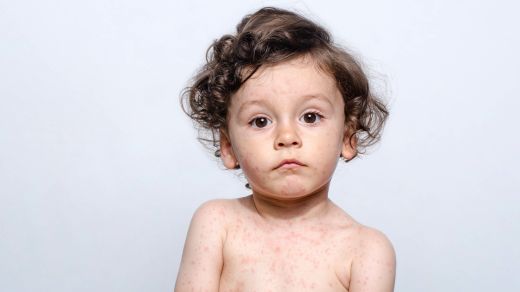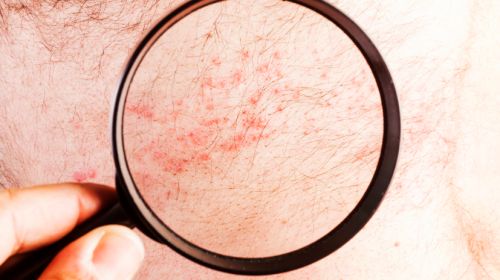Measles is one of the classic childhood diseases, but is far from harmless. Although vaccination has been available for decades, measles epidemics continue to occur in schools and kindergartens. What makes measles so dangerous and what complications are possible?
- © luanateutzi – stock.adobe.com
Quick overview: measles
Definition: Measles is an extremely contagious viral infection that can affect both children and adults.
Cause: Measles is caused by the measles virus, which is passed from person to person via droplet or smear infection.
Symptoms: In the first phase, typical flu symptoms such as fever, cough and runny nose occur, followed after a few days by a typical skin rash.
Diagnosis: A description of the symptoms and a look at the rash are usually sufficient. Measles is notifiable.
Treatment: There is no effective cure for the virus; treatment focuses on relieving symptoms and preventing complications. There is a measles vaccine to protect you.
Article content at a glance:
What is measles?
Measles (Morbilli) is an infectious disease caused by the measles virus. Although measles is considered a childhood disease, adults can also become infected if they do not have sufficient vaccination protection. In ten to 20 percent of cases, the disease is accompanied by complications such as middle ear, brain or pneumonia.
Prevent measles with vaccination
The only effective protection against infection is a measles vaccination: unvaccinated children have a 300-fold increased risk of developing measles by their tenth birthday. In Germany, the Standing Vaccination Commission (STIKO) recommends vaccinating children once at the age of eleven months and a second time at the age of 15 months. It is usually combined with the vaccines against mumps and rubella (MMR).
Anyone who has not been vaccinated or has only been vaccinated once and has had contact with an infected person can get the vaccination within three days of contact with that person and thus prevent an outbreak.
Since March 2020, according to the Measles Protection Act, there has been a measles vaccination requirement for children in daycare centers and schools (from the age of one) as well as for employees in medical and community facilities.
In order to eliminate measles, a vaccination rate of at least 95 percent of the population is necessary in Germany. Only then can outbreaks be prevented.
Typical symptoms of measles
A measles infection usually occurs in two phases. In the preliminary stage (prodomal stage), flu-like symptoms mainly occur:
On the second to fourth day of the infection, the typical skin rash appears, which is then referred to as the rash or rash stage. Starting behind the ears and on the face, small bright red dots spread over the entire body. They gradually merge into larger and darker areas, which often flake off as they subside.
As the rash spreads, the fever also increases again; in uncomplicated cases, it goes down again as the rash subsides.
Complications of measles
An infection with measles viruses temporarily weakens the immune system. During this time there is an increased susceptibility to further infections; the following diseases are particularly common in connection with measles:
In one out of a thousand cases, acute post-infectious encephalitis occurs after a measles infection: This inflammation of the brain causes serious sequelae in 20 to 30 percent of cases, and ten to 20 percent of those affected die from it. One to five in 10,000 people with measles develop subacute sclerosing panencephalitis (SSPE) six to eight years after infection, which leads to a progressive disease of the nervous system and is always fatal.
Children under five and people over 20 are at increased risk of complications.
Measles: pathogens and infection
The causative agent of measles is the measles virus, which is transmitted from person to person through droplet infection. Tiny infectious droplets (aerosols) are inhaled, which sick people expel when coughing, sneezing or speaking. Direct contact with nasal or throat secretions can also lead to infection – in this case it is referred to as a smear infection.
Measles is highly contagious: even short-term contact with a sick person over a distance of a few meters can lead to infection. Since the viruses can remain in the air for up to two hours, it is not even necessary to stay in the same room with sick people at the same time. Sick people are contagious four days before the typical skin rash appears. The contagiousness is greatest immediately before it occurs and ends four days later.
Newborns are protected by the mother’s antibodies in the first four months of life (if she is vaccinated or has already survived a measles infection). Since vaccination is not scheduled until the age of eleven months, infants between four and eleven months are particularly at risk.
Anyone who has survived a measles infection once or has been vaccinated twice has lifelong immunity against measles disease.
Diagnosis of measles
The diagnosis of measles can usually be made based on the symptoms and the typical skin rash – but there is a risk of confusion with measles
- Rubella,
- scarlet fever or
- allergic skin reactions.
Since measles is notifiable, if measles is suspected, a throat swab and/or urine test is always carried out to detect the measles virus.
Therapy: How is measles treated?
There are no effective remedies against the measles virus itself, so treatment of measles infection is aimed solely at relieving symptoms and preventing complications. Depending on the specific symptoms, fever-reducing and/or pain-relieving medications are prescribed. Antibiotics are used for additional bacterial infections (superinfections).
Those affected should take it easy, drink plenty of fluids and avoid contact with other people within the first four days after the rash appears because of the risk of infection.
Course and prognosis of measles
The majority of measles infections clear up within a few weeks without any consequences. In ten to 20 percent of cases, however, complications arise that can be fatal – especially in the case of brain inflammation.
The disease is widespread worldwide and is responsible for high child mortality, particularly in developing countries: in 2018, more than 140,000 people died from measles, the majority of whom were children under the age of five. In Germany, measles cases have fallen sharply due to the measures to contain the corona pandemic: in 2019, the Robert Koch Institute recorded 516 measles cases, in 2020 there were only 76.



